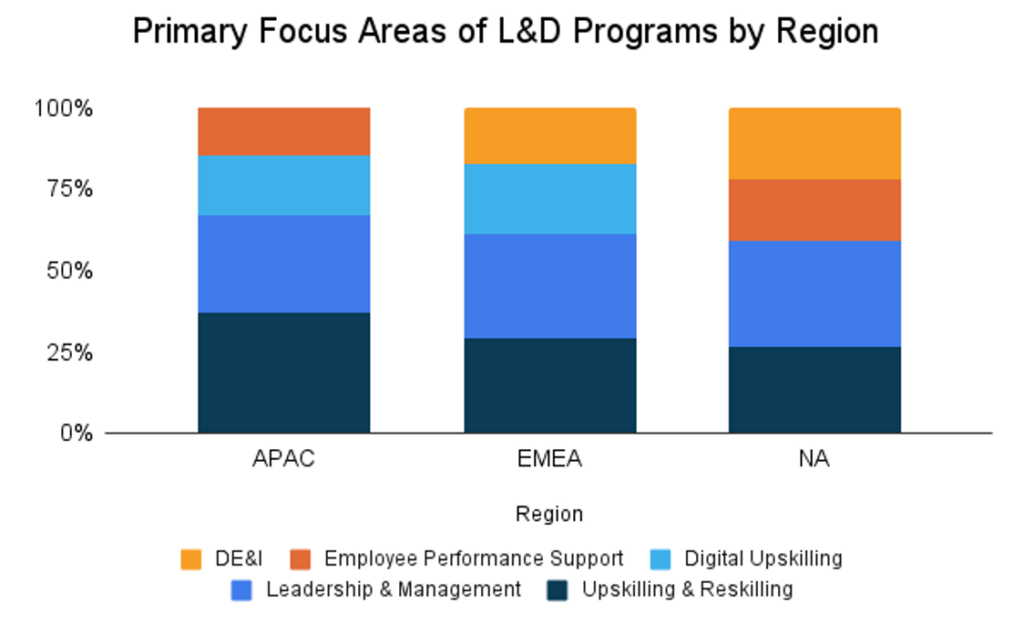Please see below for a few critical steps in the process.
In its 2022 Workplace Learning Report, LinkedIn surveyed over 1,400 learning & development (L&D) professionals and over 600 learners from around the world, and what they found will likely come as no surprise. “Learning leaders are… reaching for fresh solutions to tie skill building to career paths, internal mobility, and retention, while also bringing a new sense of care and humanity to employee well-being, diversity, and inclusion.”1 Whether for upskilling, diversity, equality, and inclusion training (DE&I), employee performance, or leadership development, L&D in the workplace is not only alive and well, it is transforming and expanding.

Data Source: LinkedIn 2022 Workplace Learning Report2
But along with a continuous upward trend in L&D comes a continuous need for eLearning translation. Organizations across industries that invest in eLearning translation meet their business objectives and enhance the eLearning experience for their global employees.
Start Your eLearning Translation Project on the Right Foot
When it comes to eLearning translation, it isn’t enough for a language services provider (LSP) to assemble a formidable team of accomplished translators with native language skills in the target languages. It isn’t enough to demonstrate a high level of competence in different disciplines. And, it certainly isn’t enough for an LSP to simply offer eLearning translation with advanced technology. Providing exceptional eLearning translation services must also include building strong relationships with clients. LSPs must strive to understand your products and services, your target markets, the industries you serve, and your eLearning objectives. Only then, can an LSP provide custom eLearning translation solutions. Building this relationship starts at the very beginning of each and every eLearning translation project and continues to the end. When done well, your trust in the LSP strengthens along with your satisfaction in the entire eLearning translation process.
In-country Review Best Practices
While it is true that LSPs should be fully transparent with their clients and explain the eLearning translation process, they should also go one step further. It is critical to each project’s success that the client plays an active role at various stages throughout the translation project. One of the most important roles you can play occurs during the in-country review process (ICR). Although ICR doesn’t take place until after the translation is complete, walking you through the entire translation process from the beginning is highly recommended. This guidance not only helps to ensure the LSP is fully aligned with your expectations but it better prepares your subject matter expert (SME) assigned to the ICR.
Overcoming Common ICR Challenges
Terminology Inconsistency
Internal alignment of terminology is one of the most common challenges organizations face when it comes to in-country reviews. If your company uses several variations of specific terms, for example, this can cause inconsistencies in your eLearning translation, ultimately leading to learner confusion. If your company already have an established style guide or terminology database, sharing this with your LSP before translation begins helps to prep the linguistic professionals. However, if you don’t yet have a style guide or an established glossary of terms, ask your LSP if they can help you create a glossary based on the eLearning content you are building. Specialized LSPs will work directly with you to identify key terminology. They will collaborate with you to make sure these key terms follow industry standards specific to each region in which your eLearning course is offered.
The use of specific technology tools to leverage consistency is also critical to overcoming challenges with inconsistency. Translation Memories (TMs), for instance, are databases that store the source text and the corresponding translation. For each new translation project, the translator will check to determine if there are any inconsistencies between the new content and the translated content stored in the TM. When inconsistencies are found, the previously approved translation will be used. TMs strengthen translation quality and consistency while decreasing time and cost
In-country Review Inconsistency
Another common challenge involves in-country review (ICR) inconsistency. If a new client review is introduced after the translation has started, it can lead to changes in specific terminology previously translated. Translation inconsistencies, poor consolidation of feedback — and ultimately, translation delays — can also occur if the client assigns multiple SMEs for larger projects. One of the most effective ways to avoid these complications is to assign one lead SME who can consolidate and verify all feedback before sharing it with the LSP.
Generally speaking, an eLearning translation project goes through nine steps:
- Review and receive the source files
- Managing kick-off meetings
- Scheduling the in-country reviews
- Create, review, and finalize your company’s glossary
- Preparing translation instructions for the linguist (style guide, TM database, glossary, etc.)
- Translating content
- Managing the side-by-side client in-country review
- Receiving linguist translation updates that align with your feedback
- Finalize the translation project
*Client can also provide an established glossary or opt-out entirely if they so choose.
Involving your in-country reviewer early on in the translation process and getting their feedback helps to ensure successful translation workflow and timely completion. Your reviewer acts as a quality check and also ensures that your company’s style and terminology are properly applied to the content. But not all clients understand how to best manage the ICR process. That is why it is important to partner with an LSP that provides step-by-step instructions and leverages the appropriate technology to improve the ICR workflow. A well-designed ICR process ensures that the LSP uses the appropriate terminology that speaks directly to the intended audience and elevates their clients as authorities in their respective fields.
Experience the eLearning Translation Difference Ingenuiti Makes
At Ingenuiti, we are fully committed to a consistent, high level of collaboration with each of our clients for every eLearning translation project. Part of this collaboration involves providing you with explicit ICR instructions before translation even begins. Together, we’ll decide on:
- One uniform method of reviewing all files
- Project timelines and review dates for in-country reviewers
- Appropriate technology tools with version control
Creating Rules of the Road
Together with our clients, we create rules of the road to help identify roles and help with the review process. Our clients’ SMEs are involved in this process and provide feedback specifically regarding their company’s style and terminology. Ingenuiti helps our clients by setting expectations at the forefront of the project. We provide your in-country reviewers with focus points instead of expecting them to focus on the translation as a whole. This also helps our qualified linguists to enhance the quality of the translation while your reviewers act as a helping hand, providing the linguists feedback on any key terms or other terminology your company requires.
Sample Translations for Larger Projects
When there are larger projects of over 50,000 words that need review, Ingenuiti provides a sample translation (or batch of files) that highlights the core key content. Once that translation is reviewed, our linguistic team will apply the stylistic preferences or key terminology introduced to the rest of the translation.
Leveraging Technology
Inspector
One of the most common challenges clients face during the review phase is a convenient way to record comments and feedback. Ingenuiti’s Inspector is the solution. Inspector is highly intuitive for the end-user and centralizes your eLearning and multimedia reviews, providing clarity of the review status and implementation of the provided feedback. Ingenuiti offers a 30-minute introductory demo, provides you with the proper instructions, and guides you during your review. Once you are introduced to Inspector, the review process is seamless.
Ingenuiti is honored to have been awarded a gold Brandon Hall Award in 2019 for our Inspector Review tool, a tool that we leverage to better support our clients by driving efficiency for their learning and video reviews.
Adam Eling, VP, Client Services, Ingenuiti, LLC
Revize
Translation review is a critical part in the eLearning translation process. Ingenuiti’s Revize addresses the many common challenges associated with the review process. Revize is fully secure and provides visibility, consistency, efficiency, collaboration, reporting, oversight, and more.
Improving the ICR Process
After the translation word document review phase is complete, Ingenuiti then localizes your course content. Your SME’s next review process will be to read the course content and sign off on the course.
The future of work will have a major impact on the global population. As we live longer, we’ll need to work longer. Providing people with lifelong learning and the skills required to adapt to technological change must become the norm.
Chairman of Royal Philips
After the translation word document review phase is complete, Ingenuiti then localizes your course content. Your SME’s next review process will be to read the course content and sign off on the course.
Overcome your eLearning challenges and enhance the eLearning experience by working with an LSP experienced in eLearning translation. Connect with Ingenuiti today and experience the difference.
References
1 2, 3 2022 workplace learning report – LinkedIn. (n.d.). Retrieved June 10, 2022
